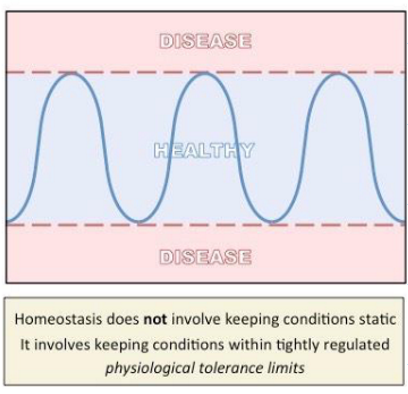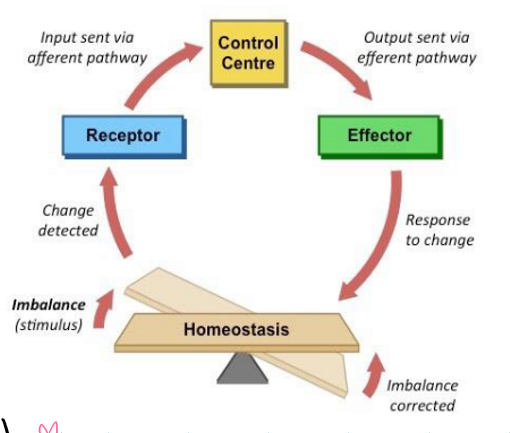-
What is physiology?
the study of the physical and chemical processes in cells, tissues, organs, and organ systems that work individually and together to sustain life
-
What is homeostasis?

the ability to maintain relatively stable conditions in the internal environment (despite changes in external environment)
-
What are some conditions considered in homeostasis?
1) pH
2) temperature
3) blood gases (CO2, O2)
4) blood pressure (b.p.)
5) intracellular + extracellular (ICF + ECF) fluid volumes
6) and many more!
-
why is homeostasis needed?
cells can only survive within a narrow range of conditions, therefore body conditions must be maintained within physiological limits
-
How does homeostasis work? What happens if it doesnt?
organ systems function together to maintain homeostasis
disease is a failure to maintain homeostasis
-
What are the roles of the nervous/endocrine system in homeostasis?
- control all other systems
- maintain homeostasis
- permit departures from homeostasis in a controlled manner e.g. pregnancy, growth, sudden fright
-
What is the general steps for the regulation of homeostasis?

-
What are the 2 types of nervous/endocrine responses?
anticipatory responses and feedback mechanisms
-
What are anticipatory responses?
- signal movement before a change in internal conditions (e.g. increased breathing at start of exercise, or putting on a coat before cold)
-
What are feedback mechanisms? What are the types?
- mechanisms that respond to change in system
- positive and negative (most common by a lot) feedback types
-
What are the 3 basic components of feedback mechanisms?
3 basic components: receptors, control areas, and effectors
-
What do the 3 basic components of feedback mechanisms do?
Receptors monitor variables/conditions
Control centers integrate info and maintain setpoints by signalling to effectors
Effectors create a response that will alter the variable/condition.
-
What are setpoints?
Setpoint = range of values of a variable (e.g. body temp.) that do not bring about a response (i.e. “normal range”)
-
What is the feedback mechanisms process?
- Variable/condition is monitored by receptors.
- Information from receptors (input) is fed back to the control area (Nervous System/endocrine gland).
- The control area (Nervous/Endocrine) then signals to the effector (output) which will bring about a response.
-
What are negative feedback mechanisms?
Most common homeostatic control mechanism
Result of “output” - variable moves back toward the set point i.e. in opposite (negative) direction to the change that triggered the response (“input”)
-
What are positive feedback mechanisms?
Less common - NOT homeostatic
Output of the feedback process intensifies the input – causes variable to move further away from set point (continues until an end point)
e.g. Childbirth – labour (end point is baby)
-
if negative feedback, what would body do if body temp increased to 40C
- dilated blood vessels bring warm core blood to the cooler skin surface and sweat evaporates.
- Results in increased heat loss & body temperature will decrease (opposite to the direction of the input/stimulus)

